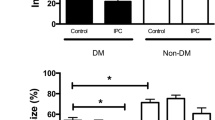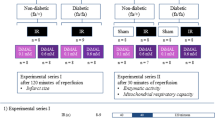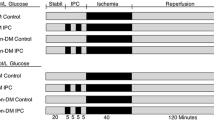Abstract
Diabetes mellitus (DM) has been reported to alter the cardiac response to ischemia–reperfusion (IR). In addition, cardioprotection induced by ischemic preconditioning (IPC) is often impaired in diabetes. We have previously shown that the subcellular localisation of the glycolytic enzyme hexokinase (HK) is causally related to IR injury and IPC protective potential. Especially the binding of HK to mitochondria and prevention of HK solubilisation (HK detachment from mitochondria) during ischemia confers cardioprotection. It is unknown whether diabetes affects HK localisation during IR and IPC as compared to non-diabetes. In this study we hypothesize that DM alters cellular trafficking of hexokinase in response to IR and IPC, possibly explaining the altered response to IR and IPC in diabetic heart. Control (CON) and type I diabetic (DM) rat hearts (65 mg/kg streptozotocin, 4 weeks) were isolated and perfused in Langendorff-mode and subjected to 35 min I and 30 min R with or without IPC (3 times 5 min I). Cytosolic and mitochondrial fractions were obtained at (1) baseline, i.e. after IPC but before I, (2) 35 min I, (3) 5 min R and (4) 30 min R. DM improved rate-pressure product recovery (RPP; 71 ± 10 % baseline (DM) versus 9 ± 1 % baseline (CON) and decreased contracture (end-diastolic pressure: 24 ± 8 mmHg (DM) vs 77 ± 4 mmHg (CON)) after IR as compared to control, and was associated with prevention of HK solubilisation at 35 min I. IPC improved cardiac function in CON but not in DM hearts. IPC in CON prevented HK solubilisation at 35 min I and at 5 min R, with a trend for increased mitochondrial HK. In contrast, the non-effective IPC in DM was associated with solubilisation of HK and decreased mitochondrial HK at early reperfusion and a reciprocal behaviour at late reperfusion. We conclude that type I DM significantly altered cellular HK translocation patterns in the heart in response to IR and IPC, possibly explaining altered response to IR and IPC in diabetes.




Similar content being viewed by others
References
Braunwald E, Kloner RA (1985) Myocardial reperfusion: a double-edge sword? J Clin Invest 76:1713–1719
Yellon DM, Hausenloy DJ (2007) Myocardial reperfusion injury. N Engl J Med 357:1110–1121
Murry CE, Jennings RB, Reimer KA (1986) Preconditioning with ischemia: a delay of lethal injury in ischemic myocardium. Circulation 74:1124–1136
Lecour S (2009) Activation of the protective survivor activating factor enhancement (SAFE) pathway against reperfusion injury: does it go beyond the RISK pathway? J Mol Cell Cardiol 47:32–40
Halestrap AP (2009) What is the mitochondrial transition pore? J Mol Cell Cardiol 46:821–831
Zuurbier CJ, Eerbeek O, Meijer AJ (2005) Ischemic preconditioning, insulin, and morphine all cause hexokinase redistribution. Am J Physiol Heart Circ Physiol 289:H496–H499
Zuurbier CJ, Smeele KMA, Eerbeek O (2009) Mitochondrial hexokinase and cardioprotection of the intact heart. J Bioenerg Biomembr 41:181–185
Gürel E, Smeele KM, Eerbeek O, Koeman A, Demirci C, Hollmann MW, Zuurbier CJ (2009) Ischemic preconditioning affects hexokinase activity and HKII in different subcellular compartments throughout cardiac ischemia-reperfusion. J Appl Physiol 106:1909–1916
Wu R, Smeele KM, Wyatt E, Ichikawa Y, Eerbeek O, Sun L, Potini V, Hollmann MW, Nagpal V, Heikkinen S, Laakso M, Jujo K, Wasserstrom JA, Zuurbier CJ, Ardehali H (2011) Reduction in hexokinase II levels results in decreased cardiac function and altered remodelling after ischemia-reperfusion injury. Circ Res 108:60–69
Smeele KMA, Southworth R, Wu R, Xie C, Nederlof R, Warley A, Nelson JK, van Horssen P, van den Wijngaard JP, Heikkinen S, Laakso M, Koeman A, Siebes M, Eerbeek O, Akar FG, Ardehali H, Hollmann MW, Zuurbier CJ (2011) Disruption of hexokinase II-mitochondrial binding blocks ischemic preconditioning and causes rapid cardiac necrosis. Circ Res 108:1165–1169
Smeele KM, Eerbeek O, Schaart G, Koeman A, Bezemer R, Nelson JK, Ince C, Nederlof R, Boek M, Laakso M, de Haan A, Drost MR, Hollmann MW, Zuurbier CJ (2012) Reduced hexokinase II impairs muscle function 2 weeks after ischemia-reperfusion through increased cell necrosis and fibrosis. J Appl Physiol 113:608–618
Kersten JR, Toller WG, Gross ER, Pagel PS, Warltier DC (2000) Diabetes abolishes ischemic preconditioning: role of glucose, insulin and osmolality. Am J Physiol Heart Circ Physiol 278:H1218–H1224
Tosaki A, Engelman DT, Engelman RM, Das DK (1996) The evolution of diabetic response to ischemia/reperfusion and preconditioning in isolated working rat hearts. Cardiovasc Res 31:526–536
Miki T, Itoh T, Sunaga D, Miura T (2012) Effects of diabetes on myocardial infarct size and cardioprotection by preconditioning and postconditioning. Cardiovasc Diabetol 11:67
Katzen HM, Soderman DD, Wiley CE (1970) Multiple forms of hexokinase. Activities associated with subcellular particulate and soluble fraction of normal and streptozotocin diabetic rat tissues. J Biol Chem 245:4081–4096
Das I (1973) Effects of heart work and insulin on glycogen metabolism in the perfused rat heart. Am J Physiol 224:7–12
Xue W, Cai L, Tan Y, Thistlethwaite P, Kang YJ, Li X, Feng W (2010) Cardiac-specific overexpression of HIF-1α prevents deterioration of glycolytic pathway and cardiac remodeling in streptozotocin-induced diabetic mice. Am J Pathol 177:97–105
Da Silva D, Ausina P, Alencar EM, Coelho WS, Zancan P, Sola-Penna M (2012) Metformin reverses hexokinase and phosphofructokinase downregulation and intracellular distribution in the heart of diabetic mice. IUBMB Life 64:766–774
Smeele KM, ter Horst LH, Koeman A, Heikkinen S, Laakso M, Weber NC, Hollmann MW, Zuurbier CJ (2011) The effects of standard chow and reduced hexokinase II on growth, cardiac and skeletal muscle hexokinase and low-flow cardiac ischaemie-reperfusion injury. Lab Animal 45:160166
Calvert JW, Gundewar S, Jha S, Greer JJM, Bestermann WH, Tian R, Lefer DJ (2008) Acute metformin therapy confers cardioprotection against myocardial infarction via AMPK-eNOS-mediated signalling. Diabetes 57:696–705
Bhamra GS, Hausenloy DJ, Davidson SM, Carr RD, Paiva M, Wynne AM, Mocanu MM, Yellon DM (2008) Metformin protects the ischemic heart by the Akt-mediated inhibition of mitochondrial permeability transition pore. Basic Res Cardiol 103:274–284
Gross ER, Hsu AK, Gross GJ (2007) Diabetes abolishes morphine-induced cardioprotection via multiple pathways upstream of glycogen synthase kinase-3beta. Diabetes 56:127–136
Ghaboura N, Tamareille S, Ducluzeau PH, Grimaud L, Loufrani L, Croue A, Tourmen Y, Henrion D, Furber A, Prunier F (2011) Diabetes mellitus abrogates erythropoietin-induced cardioprotection against ischemic-reperfusion injury by alteration of the RISK/GSK-3β signalling. Basic Res Cardiol 106:147–162
Wu Y, Xia ZY, Dou J, Zhang L, Xu JJ, Zhao B, Lei S, Liu HM (2011) Protective effect of ginsenoside Rb1 against myocardial ischemia/reperfusion injury in streptozotocin-induced diabetic rats. Mol Biol Rep 38:4327–4335
Xu G, Takashi E, Kudo M, Ishiwata T, Naito Z (2004) Contradictory effects of short- and long-term hyperglycemia on ischemic injury of myocardium via intracellular signalling pathway. Exp Mol Pathol 76:57–65
Da-Silva WS, Gomez-Puyou A, Gomez-Puyou MT, Moreno-Sanchez R, De Felice FG, De Meis L, Oliveira MF, Galina A (2004) Mitochondrial bound hexokinase activity as a preventive antioxidant defense. J Biol Chem 279:39846–39855
Pasdois P, Parker JE, Griffiths EJ, Halestrap AP (2011) The role of oxidized cytochrome c in regulating mitochondrial reactive oxygen species production and its perturbation in ischaemia. Biochem J 436:493–505
Majewski N, Nogueira V, Robey RR, Hay N (2004) Akt inhibits apoptosis downstream of BID cleavage via a glucose-dependent mechanism involving mitochondrial hexokinase. Mol Cell Biol 24:730–740
Ye G, Donthi RV, Metreveli NS, Epstein PN (2005) Overexpression of hexokinase protects hypoxic and diabetic cardiomyocytes by increasing ATP generation. Cardiovasc Toxicol 5:293–300
Balakumar P, Sharma NK (2012) Healing the diabetic heart: does myocardial preconditioning work? Cell Signal 24: 53–59
Miyamoto S, Murphy AN, Brown JH (2008) Akt mediates mitochondrial protection in cardiomyocytes through phosphorylation of mitochondrial hexokinase-II. Cell Death Differ 15:521–529
Murphy E, Steenbergen C (2008) Mechanisms underlying acute protection from cardiac ischemia-reperfusion injury. Physiol Rev 88:581–609
Hotta H, Miura T, Miki T, Togashi N, Maeda T, Kim SJ, Tanno M, Yano T, Kuno A, Itoh T, Satoh T, Terashima Y, Ishikawa S, Shimamoto K (2010) Angiotensin II type 1 receptor-mediated upregualtion of calcineurin activity underlies impairment of cardioprotective signaling in diabetic hearts. Circ Res 106:129–132
Miki T, Miura T, Hotta H, Tanno M, Yano T, Sato T, Terashima Y, Takada A, Ishikawa S, Shimamoto K (2009) Endoplasmic reticulum stress in diabetic hearts abolishes erythropoietin-induced myocardial protection by impairment of phosphor-glycogen synthase kinase-3beta-mediated suppression of mitochondrial permeability transition. Diabetes 58:2863–2872
Drenger B, Ostrovsky IA, Barak M, Nechemia-Arbely Y, Ziv E, Axelrod JH (2011) Diabetes blockade of sevoflurane postconditioning is not restored by insulin in the rat heart: phosphorylated signal transducer and activator of transcription 3- and phosphatidylinositol 3-kinase mediated inhibition. Anesthesiology 114:1364–1372
Kewalramani G, An D, Suk Kim M, Ghosh S, Qi D, Abrahani A, Pulinilkunnil T, Sharma V, Wambolt RB, Allard MF, Innis SM, Rodrigues B (2007) AMPK control of myocardial fatty acid metabolism fluctuates with the intensity of insulin-deficient diabetes. J Mol Cell Cardiol 42:333–342
Juhaszova M, Zorov DB, Kim SH, Pepe S, Fu Q, Fishbein KW, Ziman BD, Wang S, Ytrehus K, Antos CL, Olson EN, Sollott SJ (2004) Glycogen synthase kinase-3beta mediates convergence of protection to inhibit the mitochondrial permeability transition pore. J Clin Invest 113: 1535–1549
Pastorino JG, Hoek JB, Shulga N (2005) Activation of glycogen synthase kinase -3beta disrupts the binding of hexokinase II to mitochondria by phosphorylating voltage dependent anion channel and potentiates chemotherapy-induced cytotoxicity. Cancer Res 65:10545–10554
Acknowledgments
This study was supported by The Scientific and Technological Research Council of Turkey (TUBITAK) (Project No: TBAG-107T212) and by Scientific Research Projects Coordination Unit of Istanbul University (Grants UDP-16146, UDP-25255).
Author information
Authors and Affiliations
Corresponding author
Rights and permissions
About this article
Cite this article
Gurel, E., Ustunova, S., Kapucu, A. et al. Hexokinase cellular trafficking in ischemia–reperfusion and ischemic preconditioning is altered in type I diabetic heart. Mol Biol Rep 40, 4153–4160 (2013). https://doi.org/10.1007/s11033-013-2495-5
Received:
Accepted:
Published:
Issue Date:
DOI: https://doi.org/10.1007/s11033-013-2495-5




